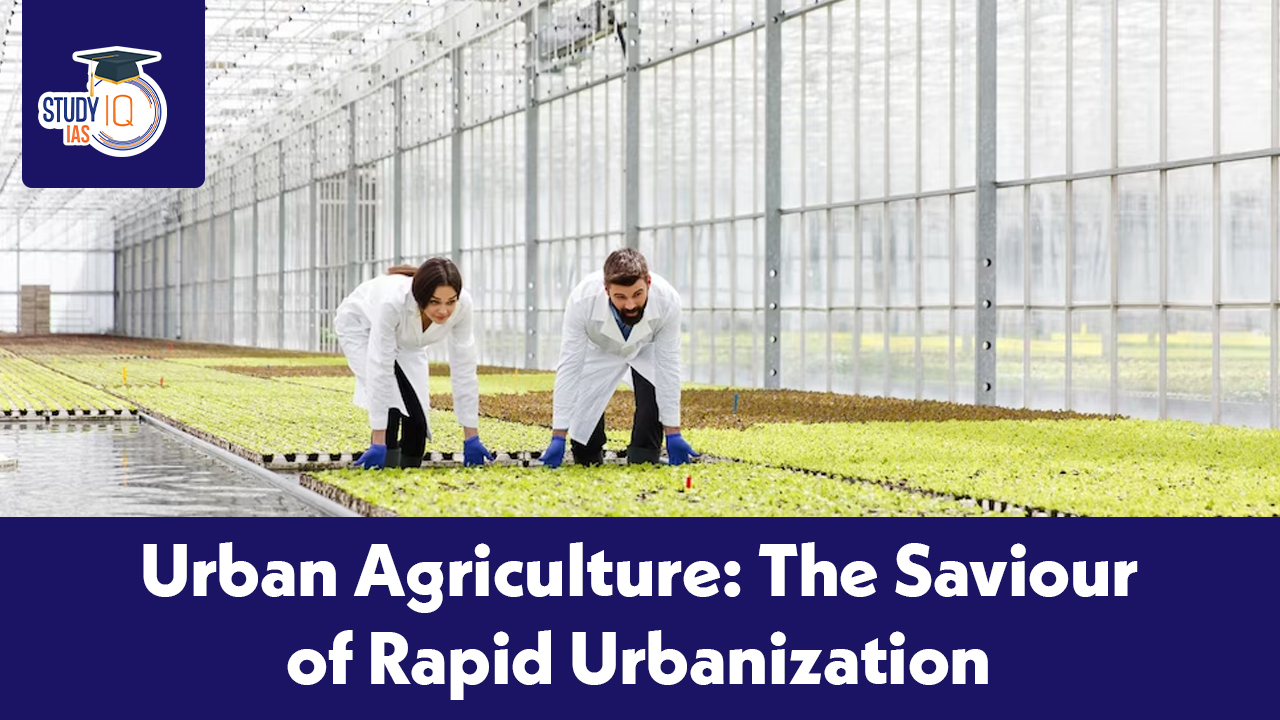Table of Contents
Context: According to a market research study, the global urban farming market size is expected to grow to US$ 281.9 billion by 2030 from US$ 137.5 billion in 2021, with a CAGR of 3.1%.
Introduction: Urban agriculture is a key solution to rapid population growth, urbanization, food crisis and climate change. According to reports of FAO, by 2050, more than 6 billion populations will be dwelling in urban areas, which is almost double the current population of 3.5 billion. In case of India, the reports by UN, by 2030, 40.76% of country’s population will reside in urban areas. Considering these statistics, we can estimate the burden on rural production system to meet increasing food demand in urban markets. So, urban agriculture could be the saviour to avoid food crisis.
What is Urban Agriculture?
- Urban agriculture, also known as urban farming, urban gardening, refers to the practice of cultivating, producing, and processing food and other agricultural products within or near urban areas.
- This form of agriculture takes place in urban environments and utilizes available spaces such as rooftops, balconies, vacant lots, community gardens, and even indoor facilities for cultivation.
- Urban agriculture involves a variety of activities, including growing crops, raising animals, keeping bees, and practicing aquaculture.
- Its primary goal is to provide fresh and locally sourced food to urban communities while addressing challenges posed by rapid urbanization, population growth, food insecurity, and climate change.
Types of Urban Agriculture
Urban agriculture can be classified into large number of types based on area, type of commodity produced, multiple methods and medium used for cultivation.
- Kitchen gardening: Cultivation of vegetables and herbs in and around the domestic area for daily kitchen use.
- Rooftop Gardening: Rooftop gardens involve growing plants on the rooftops of buildings. They can range from small container gardens to larger intensive systems.
- Community Gardens: Community gardens are shared spaces where local residents come together to collectively cultivate plants.
- Vertical Farming: Vertical farming involves growing crops in vertically stacked layers, often indoors, using controlled environments and artificial lighting.
- Hydroponics and Aquaponics: Hydroponics is a soilless method of growing plants using nutrient-rich water solutions, while aquaponics combines hydroponics with fish farming.
- Container Gardening: Container gardening involves growing plants in pots, containers, or other portable vessels.
- Street landscaping: The vacant area alongside of the streets can be utilized for cultivation of vegetables.
- Green house gardening: The large empty areas in and around the locality can be covered with the greenhouse for production of high value crops.
- Peri-urban farming: Cultivation of crops in the city outskirts or perimeter of the urban areas is peri-urban farming.
- Urban beekeeping: Maintaining bee colonies in and around urban gardens or peri-urban areas for pollination and for their honey is called urban beekeeping.
Advantages of Urban Agriculture
- Food Security and Access: Urban agriculture provides an opportunity to produce fresh and nutritious food locally, reducing the dependency on distant rural sources.
- Environmental Sustainability: Urban agriculture contributes to creating green spaces in cities, which can help mitigate the heat island effect, improve air quality, and promote biodiversity.
- Climate Change Resilience: Urban agriculture can enhance a city’s resilience to climate change by improving water management, reducing soil erosion, and promoting sustainable land use practices.
- Social and emotional well-being: Urban farming on community bases leads to social interaction among people of the locality, children can learn agriculture, people can share their produce with neighbours and social interactions will improve over time.
- Agriculture as a hobby is a best mental and physical exercise to improve your emotional wellbeing.
- Economic benefits: Urban agriculture provides employment and incomes for poor women and other disadvantaged groups.
Disadvantages of Urban Agriculture
- Lack of recognition: Urban farming is unrecognized in agricultural policies and urban planning thus ignoring its importance in agriculture production system.
- Regulatory vacuum: Growers often operate without permits. Since it is officially “invisible”, the sector receives no public assistance or oversight in many cities.
- Health and environmental risks: Urban agriculture carries health and environmental risks – potential use of contaminated land and water and inappropriate use of pesticides, fertilizers and of raw organic manure that can leak into water sources.
- Groundwater depletion: Drastic reduction in rainwater infiltration into the soil.
- In Harare, Zimbabwe, it was noticed that there was 28.5% reduction in rainwater infiltration leading to depletion of groundwater.
- Other concerns: The other challenges faced by urban farms are higher production costs, difficulty in managing pests and weeds and changing climatic scenario.
- Operating urban farms within limited spaces can result in higher production costs due to the need for specialized equipment, irrigation systems, and controlled environments.
- Urban agriculture may face challenges in managing pests and weeds in densely populated areas.
- Urban areas may experience microclimates and heat island effects that differ from rural areas. This can affect plant growth, water requirements, and overall crop health.
Success Stories of Urban Agriculture in India and World
| Cairo, Egypt |
|
| Queensland, Australia |
|
| Havana, Cuba |
|
| Beijing, China: |
|
| Yorkshire, United Kingdom |
|
| Mumbai, India |
|
| Hyderabad, India |
|
Conclusion: The rapid increase in the population, excessive immigration into urban areas and increased demand for fruits and vegetables has caused frequent food shortages, inflations in food prices and sometimes food crisis in Indian markets. The saying “agriculture is a gamble with climate” suits the fluctuations in production and productivity in rural areas. Understanding these lacunas would suggest “urban farming” as a major solution.


 SSC CGL Exam 2025 Apply Online Starts Ap...
SSC CGL Exam 2025 Apply Online Starts Ap...
 Daily Quiz 19 April 2025
Daily Quiz 19 April 2025
 Vehicle-to-Grid (V2G) Technology and its...
Vehicle-to-Grid (V2G) Technology and its...





















